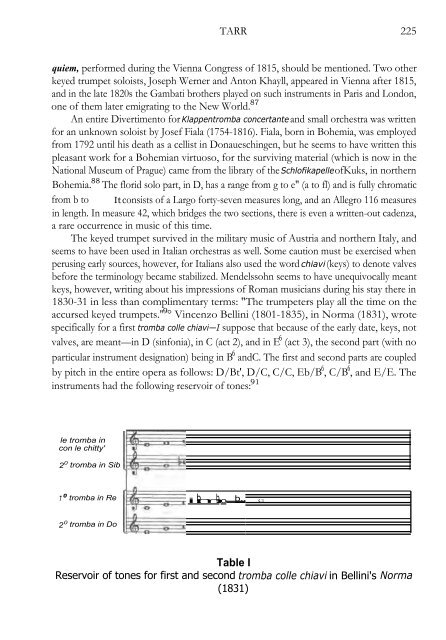THE ROMANTIC TRUMPET - Historic Brass Society
THE ROMANTIC TRUMPET - Historic Brass Society
THE ROMANTIC TRUMPET - Historic Brass Society
Create successful ePaper yourself
Turn your PDF publications into a flip-book with our unique Google optimized e-Paper software.
TARR 225<br />
quiem, performed during the Vienna Congress of 1815, should be mentioned. Two other<br />
keyed trumpet soloists, Joseph Werner and Anton Khayll, appeared in Vienna after 1815,<br />
and in the late 1820s the Gambati brothers played on such instruments in Paris and London,<br />
one of them later emigrating to the New World. 87<br />
An entire Divertimento for Klappentromba concertante and small orchestra was written<br />
for an unknown soloist by Josef Fiala (1754-1816). Fiala, born in Bohemia, was employed<br />
from 1792 until his death as a cellist in Donaueschingen, but he seems to have written this<br />
pleasant work for a Bohemian virtuoso, for the surviving material (which is now in the<br />
National Museum of Prague) came from the library of the Schlofikapelle ofKuks, in northern<br />
Bohemia. 88 The florid solo part, in D, has a range from g to e" (a to fl) and is fully chromatic<br />
from b to It consists of a Largo forty-seven measures long, and an Allegro 116 measures<br />
in length. In measure 42, which bridges the two sections, there is even a written-out cadenza,<br />
a rare occurrence in music of this time.<br />
The keyed trumpet survived in the military music of Austria and northern Italy, and<br />
seems to have been used in Italian orchestras as well. Some caution must be exercised when<br />
perusing early sources, however, for Italians also used the word chiavi (keys) to denote valves<br />
before the terminology became stabilized. Mendelssohn seems to have unequivocally meant<br />
keys, however, writing about his impressions of Roman musicians during his stay there in<br />
1830-31 in less than complimentary terms: "The trumpeters play all the time on the<br />
accursed keyed trumpets." 9 ° Vincenzo Bellini (1801-1835), in Norma (1831), wrote<br />
specifically for a first tromba colle chiavi—I suppose that because of the early date, keys, not<br />
valves, are meant—in D (sinfonia), in C (act 2), and in E 6 (act 3), the second part (with no<br />
particular instrument designation) being in B 6 andC. The first and second parts are coupled<br />
by pitch in the entire opera as follows: D/Bt', D/C, C/C, Eb/B 6 , C/B 6 , and E/E. The<br />
instruments had the following reservoir of tones: 91<br />
le tromba in<br />
con le chitty'<br />
2 0 tromba in Sib<br />
7 0 tromba in Re<br />
imb b o b.. ( 71<br />
2 0 tromba in Do<br />
Table I<br />
Reservoir of tones for first and second tromba colle chiavi in Bellini's Norma<br />
(1831)
















